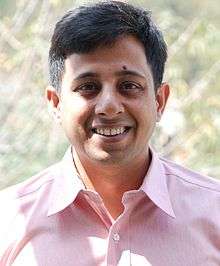Anuj Dhar
| Anuj Dhar | |
|---|---|
 | |
| Occupation | Author |
Anuj Dhar is an Indian author and former journalist.[1] Dhar has published several books on the death of Subhas Chandra Bose which (according to official and academic views) occurred on 18 August 1945, when a Japanese plane carrying him crashed in Japanese-occupied Taiwan. Dhar claims in his books that there was no air crash and that Bose actually died in the 1980s after living as hermit monk named "Gumnami Baba Bhagwanji" in Faizabad.[1][2][3] Dhar is also the founder-trustee of New Delhi-based not for profit organisation Mission Netaji.
Claims
Gumnami Baba Bhagwanji
Dhar and Mission Netaji investigate the claims that Bose lived in the Uttar Pradesh state of India as a hermit till 1985.[4]
Other claims
Reportedly, at his funeral on 18 September 1985, one of the 13 attendants cried out, "…there should have been 13 lakh people here!"[2]
In 2005, the Taiwan government provided emails to Dhar that it has no records of a plane crash during the period of 14 August to 25 October 1945, at the old Matsuyama Airport (now Taipei Domestic Airport).[5]
Counter claims
The scholarly view is that Bose died in the air crash and that theories that he did not are incorrect, speculative, mythical, and possibly fabricated[6][7][8][9][10][11] However, Mission Netaji claims that Dhar's research will prove that Bose actually escaped to the Soviet Union after the war.[4] Justice Mukherjee Commission which probed the death of Subhas Bose later concurred with Dhar's claim that Bose was not killed in Taiwan,[12] although the Indian government rejected the findings.[13]
In the book No Secrets, Dhar claims that, according to a newspaper article published by Bose's elder brother Sarat Chandra Bose in The Nation, Bose was in China in October 1949.[14]
Dhar's 2008 book, CIA's Eye on South Asia, compiled declassified Central Intelligence Agency records on India and its neighbours.[15]
Criticism
Anuj Dhar is also criticised for sensationalizing the stories and spreading unproven facts as near truth in social media and his books. His views were found biased by many and he also found as intolerant to alternate views and criticism. Some people also doubted on the authenticity of the documents that he provides to substantiate his arguments. Highly regarded Netaji biographer Leaonard A. Gordon also penned a critical note on Dhar in a postscript of his book 'Brothers Against the Raj'. There Gordon also pointed to, like many others in social media, the fact that Dhar misuses the Subhas Bose death mystery issue for contemporary Indian political purposes.[16]
Bibliography
- Back from Dead: Inside the Subhas Bose Mystery (2005), Manas Publications, ISBN 81-7049-237-8[17]
- CIA's Eye on South Asia (2008), Manas Publications, ISBN 978-81-7049-346-4[15]
- India's Biggest Cover-up (2012), Vitasta Publishing, ISBN 978-93-80828-69-5[17]
- No Secrets (2013), Vitasta Publishing, ISBN 978-93-82711-05-6
References
- 1 2 Hugh Purcell. "Subhas Chandra Bose: The Afterlife of India's Fascist Leader". History Today, Volume: 60 Issue: 11 2010. Retrieved 7 November 2013.
- 1 2 "A Saint with no name". The Daily Star. The Daily Star. 16 January 2015. Retrieved 31 January 2015.
- ↑ Kirpal, Raman (12 July 2012). "Why Subhas Chandra Bose's death is India's 'biggest cover-up'". First Post India.
- 1 2 "Netaji did not die in aircrash, says web site". Rediff.com. 18 March 2006. Retrieved 7 November 2013.
- ↑ "No crash at Taipei that killed Netaji: Taiwan govt". Kolkata: Outlook India. 3 February 2005. Retrieved 7 November 2013.
- ↑ Bandyopādhyāẏa, Śekhara (2004), From Plassey to Partition: A History of Modern India, Orient Blackswan, ISBN 978-81-250-2596-2, retrieved 21 September 2013
- ↑ Bayly, Christopher; Harper, Timothy (2007), Forgotten Wars: Freedom and Revolution in Southeast Asia, Harvard University Press, ISBN 978-0-674-02153-2, retrieved 21 September 2013
- ↑ Bose, Sugata (2011), His Majesty's Opponent: Subhas Chandra Bose and India's Struggle against Empire, Harvard University Press, ISBN 978-0-674-04754-9, retrieved 22 September 2013
- ↑ Metcalf, Barbara D.; Metcalf, Thomas R. (2012), A Concise History of Modern India, Cambridge University Press, ISBN 978-1-107-02649-0, retrieved 21 September 2013
- ↑ Wolpert, Stanley A. (2000), A New History of India, Oxford University Press, ISBN 978-0-19-512877-2, retrieved 6 November 2013
- ↑ Wolpert, Stanley (2009), Shameful Flight: The Last Years of the British Empire in India, Oxford University Press, ISBN 978-0-19-539394-1, retrieved 21 September 2013
- ↑ "Netaji's dead but didn't die in crash, says report; long live the mystery". Indian Express.
- ↑ "The debate lives on". India Today.
- ↑ "New book seeks to solve Netaji mystery with brother's China claim". Kolkata: Indian Express. 19 October 2013. Retrieved 7 November 2013.
- 1 2 Dhawan, Himanshi (1 May 2009). "Reveal names of moles in Indira cabinet: CIC to govt". Times of India. Retrieved 7 November 2013.
- ↑ Leaonard A. Gordon (2014). Brothers Against the Raj: A Biography of Indian Nationalists Sarat and Subhas Chandra Bose. Blaft Publications. pp. 392–394. ISBN 8129136635.
- 1 2 "'India's biggest cover-up', book on Netaji mystery launched". Kolkata: The Economic Times. 17 November 2012. Retrieved 7 November 2013.